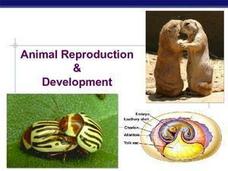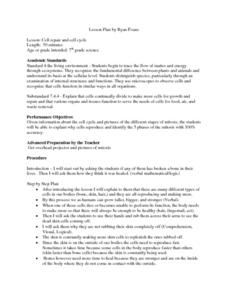Curated OER
Are Adult Pancreatic Beta Cells Formed by Self-duplication or Stem Cell Differentiation?
A case-study of Dr. Melton's experiment on pancreatic cells highlights this worksheet. Details of the study adorn the first three pages, complete with diagrams. Biology buffs then analyze the data and identify problems within the...
Cornell University
Light Waves: Grades 6-8
Explore the behavior of light with different materials. Collaborative groups determine whether certain materials absorb, reflect, diffract, or transmit light waves. They then measure the angle of incidence and angle of reflection.
Curated OER
Alcohol and Pregnancy Don't Mix!
Seventh graders learn about John Kellerman, a youngster who was born with Fetal Alcohol Syndrome. They learn how alcohol and pregnancy doesn't mix.
Curated OER
Animal Reproduction and Development
Details of fertilization, cleavage, the placenta and fetal development are presented, along with important diagrams and illustrations. By using these slides, you and your students will generate discussion points, along with details...
Curated OER
Anatomy and Physiology "Quickies"
Students use a variety of creative writing tools within this assignment: poems on particular organ systems, write a short story and/or create a word graph. They are involved in a demonstration of lactic build up in the muscles, a...
Curated OER
Household Hazardous Waste Reduction
Learners discover the different types of hazardous waste. They examine ways to dispose of the hazardous materials safely and without harming the environment.
Curated OER
Nerve Cell Informercials
Young scholars research the structure and function of the nervous system. They prepare a model or representation of neural transmission. Students create an infomercial about nerve cells.
Curated OER
Cloning
In this opinions of cloning usage worksheet, students read phrases of what cloning should be used for and check their opinions in columns yes, not sure, no, only in certain situations, and never.
Curated OER
Cells: Nature's Building Blocks
What you will find on this page is the general outline of a unit on the use of a microscope and the structure of the cell. There is no actual educational content here, so you will need to design the details of each of the four student...
Curated OER
Broken Bones
Students listen to a lecture on broken bones. They review the proper first aid techniques and practice setting splints on one another. They observe X-rays and animal bones.
Curated OER
Totally Cellular
For this biology worksheet, students learn about cells and their various parts. They first read a page and a half of facts about cells and then answer the 10 questions in the packet. The answers are on the last page.
Curated OER
Habitat
Fourth graders study the components of a habitat. For this animal habitat lesson, 4th graders define the elements of a habitat. Students discuss intertidal habitats and make a habitat for a crab.
Curated OER
Cellular Cellebrities
Sixth graders, in groups, learn the morphology and function of organelles within plant and animal cells.
Curated OER
Acids and Bases Are All Around
In this acids and bases activity, students read a 1 page article on acids and bases and answer 10 true or false, short answer, multiple choice and/or fill in the blank questions or statements referring back to the article.
Curated OER
Different Types of Orange Juice Contain the Same Amounts of Vitamin C?
Students measure and compare the amount of vitamin C in orange juice samples. They discover the effects of different factors on the concentration of vitamin C. They participate in an experiment to test the orange juice.
Curated OER
You, Me and UV
Students explore the validity of claims of UV protection. Students research UV rays and the cancer danger presented by these rays. Working in groups, they perform tests on sunglass and sunscreen products to determine if their claim of UV...
Curated OER
Cell Repair and Cell Cycle
Seventh graders explore the cell cycle. They view pictures of different stages of mitosis and explain why cells reproduce. They identify the five phases of mitosis: interphase, prophase, metaphase, anaphase, and telophase.
University of Kansas Medical Center
University of Kansas Medical Center: Basic Histopathology
These microscopic images of different cells and tissues from the human organs gives an idea of some the pathological processes that occur and the importance of histology.

















